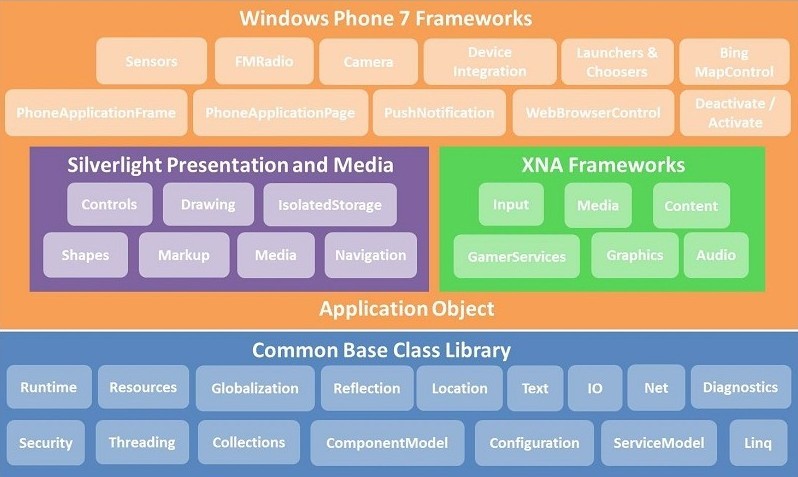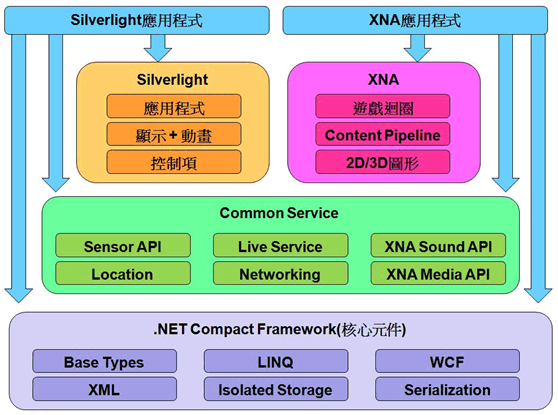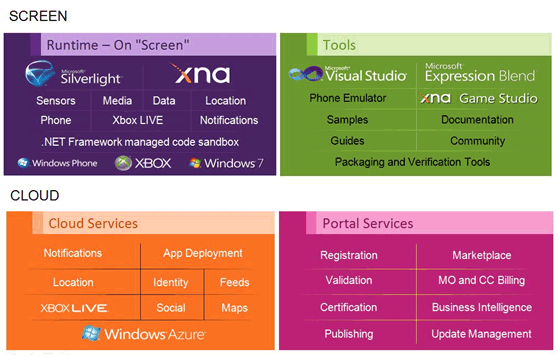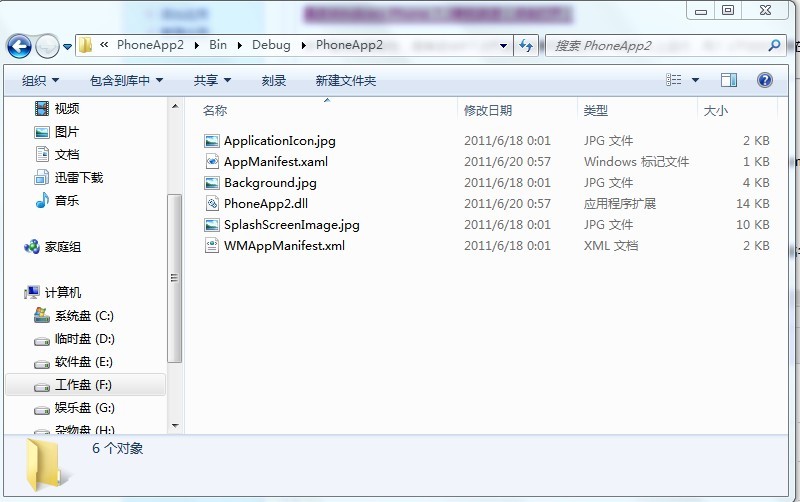上一篇文章介绍了Windows Phone的开发环境和一个简单的Windows Phone程序的演示和结构,这一篇文章要深入一点,介绍Windows Phone的框架结构和程序启动的过程。
在进行Windows Phone开发之前有必要了解一下整个全新平台的结构。对于Windows Phone平台来说,区别于之前的Windows Mobile平台最大的区别是他运行环境完全基于.NET框架,他只支持托管代码进行开发。

Windows Phone是基于.NET Compact Framework框架,所以精简了很多桌面版的功能。但是还是提供了所需的基本功能。如上图中的最下层的蓝色部分,就是.NET CF提供的BCL类库。而在他的上层就是Application Object。这一层都是基于.NET CF框架。其中包含了两种开发框架:
毕竟移动手机平台还有自己特殊的一部分功能,所以在两个框架的上层Windows Phone特有的一些功能,比如相机,Windows Phone控件,感应器,多点触控屏幕,Launcher,Chooser等等来提供相应功能。

所以具体到实际开发,我们有2套开发框架进行选择,对于大多应用程序我们可以选择Silverlight进行开发,而对于游戏可以选择XNA。但是WP也提供部分功能相互调用的功能。而对以WP7.1来说可以建立一个silverlight和XNA集成的开发环境(点击查看)。

对于Windows Phone开发来说,不仅可以使用.NET CF和silverlight或XNA框架提供的这些功能,还能使用微软基于云服务的一些功能。比如Notification,Social, Location,Map ,Azure等服务。下图显示了Windows Phone上支持的的运行时框架和开发工具。下面的显示提供的运服务以及注册开发者和发布程序。他们组成了对Windows Phone开发的软件支持。

而对于硬件来说,微软统一了硬件平台,目前要求的硬件包括 800 x 480 或 480 x 320 屏幕分辨率,支持多点触控,内建 A-GPS 卫星定位系统,G-Sensor (Accelerometer),电子罗盘传感器,光源传感器,以及不需要直接接触就可以侦测到附近物体的 Proximity Sensor。最少 500 万画素的数字相机,内建 Codec 与多媒体影音播放功能,最少 256MB 的 RAM 与最少 8GB 的闪存,GPU (图形处理器),ARMv7 Cortex/Scorpion 或更佳的处理器,以及 Back、Start、Search 三个硬件按键。目前HTC和三星已经有第一代的WP7手机上市,可以机型和ROM信息可以参见:智机网
关于Windows Phone Plateform的详细介绍参见MSND(点击打开)
目前最新版本的系统是Windows Phone 7.1Beta,相对于Windows Phone他有了比较大的改动,弄清楚每一版本的功能,可以更好的了解系统和选择开发的版本。
关于程序的兼容性,简单说WP7.0开发的程序可以在OS7.0和7.1上运行,而7.1开放的程序在7.0上可能会失败。具体兼容性问题参见这里
在我们上一篇文章中,我们写了一个简单的Demo程序。程序启动后显示的是MainPage.xaml页面。那么程序是如何成功启动的呢?
1 xap文件
打开程序后,我们对程序进行编译,然后我们可以在/PhoneApp2/Bin/Debug目录下看到名字为PhoneApp.xap文件,这个就是我们程序的包。部署到手机上就能运行。这其实是一个压缩文件,我们可以用7-ZIP来解压。

其中包含了程序使用的3个JPG文件,PhoneApp2.dll就是我们程序功能的DLL文件,而AppMainfest.xaml和WMAppMaingest.xml文件则提供了应用程序的一些信息。

上图是一个silverlight的XAP包的结构,WP基于silverlight开发的程序结构是相似的,不过多一个WMAppMaingest.xml文件,用来配置手机相关的一些信息,这个在上一篇有介绍过。首先来看看AppManifest.xaml 文件,它标识打包的程序集和应用程序入口点。
<Deployment xmlns="http://schemas.microsoft.com/client/2007/deployment" xmlns:x="http://schemas.microsoft.com/winfx/2006/xaml" EntryPointAssembly="PhoneApp2" EntryPointType="PhoneApp2.App" RuntimeVersion="4.7.50308.0"> <Deployment.Parts> <AssemblyPart x:Name="PhoneApp2" Source="PhoneApp2.dll" /> </Deployment.Parts> </Deployment>
这个和上一篇文章相比,已经自动生成了一些内容。我们来简单看一下:
关于xap包结构和此文件结构具体信息,详细可以参考silverlight的应用程序结构。对于WMAppMaingest.xml文件没和编译前没有变化,详细结构上一篇文章中有链接介绍。
AppMaingest.axml中定义了程序的入口点,其中指定了App对象。通过查看这2个文件,我们发现App.xaml.cs文件中定义了App类,此类继承与Application类,而App.xaml文件的根节点Application指定了x:Class="PhoneApp2.App",这个表示把xaml文件中的内容同xaml.cs类中内容合并。这里所有内容编译后会合并到App类中。
当使用 Silverlight 的托管 API 创建应用程序时,必须创建一个从 Application 派生的类。Application 类提供应用程序通常要求的若干服务。它主要表示应用程序代码在 Silverlight 插件生命周期中的入口点。Application类的以下功能:
<Application x:Class="PhoneApp2.App" xmlns="http://schemas.microsoft.com/winfx/2006/xaml/presentation" xmlns:x="http://schemas.microsoft.com/winfx/2006/xaml" xmlns:phone="clr-namespace:Microsoft.Phone.Controls;assembly=Microsoft.Phone" xmlns:shell="clr-namespace:Microsoft.Phone.Shell;assembly=Microsoft.Phone"> <!--Application Resources--> <Application.Resources> </Application.Resources> <Application.ApplicationLifetimeObjects> <!--Required object that handles lifetime events for the application--> <shell:PhoneApplicationService Launching="Application_Launching" Closing="Application_Closing" Activated="Application_Activated" Deactivated="Application_Deactivated"/> </Application.ApplicationLifetimeObjects> </Application>
我们看到App.xaml文件中定义了<Application.Resources>节电,这个可以用来定义一些全局的资源别如string,style,笔刷等;<Application.ApplicationLifetimeObjects>则是提供了对Application的扩展性,这里提供了PhoneApplivationService的扩展服务,从名字我们就能知道这个是有关Phone的扩展,因为默认的Silverlight是没有的。这个是位于Micresoft.Phone.dll中,这儿服务提供了4个与手机有关的方法。关于扩展性可以参见silvrlight的扩展服务
public PhoneApplicationFrame RootFrame { get; private set; } public App() { UnhandledException += Application_UnhandledException; InitializeComponent(); InitializePhoneApplication(); PhoneApplicationService.Current.UserIdleDetectionMode = IdleDetectionMode.Disabled; }
以上是App.xaml.cs文件中的代码,首先定义了一个PhoneApplicationFrame属性RootFrame,在构造函数中定义了UnhandledException来处理未处理异常,这是Application的一个功能;InitializeComponent是初始化方法,点击F12导航到App.g.i.cs文件,这个是系统自动根据xaml生成的。
public void InitializeComponent() { if (_contentLoaded) { return; } _contentLoaded = true; System.Windows.Application.LoadComponent(this, new System.Uri("/PhoneApp2;component/App.xaml", System.UriKind.Relative)); }
这里调用了Application.LoadComponent方法。这个方法的作用是 加载位于指定统一资源标识符 (URI) 处的 XAML 文件,并将其转换为由该 XAML 文件的根元素指定的对象的实例。这里就是生成App类的实例对象。用Reflector看没有代码,我们可以看看Silverlight中的实现:
//部分代码 public static void LoadComponent(object component, Uri resourceLocator) { XcpImports.CheckThread(); Type componentType = null; uint hr = 0; if (IsComponentUri(resourceLocator)) { string partName = null; string assemblyName = null; string assemblyVersion = null; string assemblyKey = null; if (!QuirksMode.ShouldUseSL3Parser()) { ResourceManagerWrapper.GetAssemblyNameAndPart(resourceLocator, out partName, out assemblyName, out assemblyVersion, out assemblyKey); } if (componentType == null) { componentType = component.GetType(); } UnmanagedMemoryStream resourceForUri = ResourceManagerWrapper.GetResourceForUri(resourceLocator, componentType) as UnmanagedMemoryStream; if (resourceForUri != null) { uint length = (uint) resourceForUri.Length; hr = XcpImports.Application_LoadComponent(ManagedObjectReference.ConditionalWrap(component), resourceLocator.OriginalString, resourceForUri, length, assemblyName); resourceForUri.Close(); } } else { hr = XcpImports.Application_LoadComponent(ManagedObjectReference.ConditionalWrap(component), resourceLocator.OriginalString, null, 0, string.Empty); } }
首先获得了程序集相关的信息,然后获得Uri的资源,最后XcpImports是.NET部分调用core部分的接口,core部分是用C++编写的Core presentation framework,主要功能是XAML parser, UI Core, Inputs, DRM(digital rights management), Media, Deep Zoom等,多数是需直接与具体的操作系统API打交道的功能(可以参考:Silverlight CoreCLR结构浅析)。最终加载的是一个Application_LoadComponentNative的Native方法。
nternal static unsafe uint Application_LoadComponent(IManagedPeerBase componentAsDO, string resourceLocator, UnmanagedMemoryStream stream, uint numBytesToRead, string assemblyString) { if (assemblyString == null) { assemblyString = string.Empty; } CheckThread(); byte* pXamlStr = (stream != null) ? stream.PositionPointer : null; uint num = Application_LoadComponentNative(JoltHelper.Context, componentAsDO.NativeObject, (uint) resourceLocator.Length, resourceLocator, numBytesToRead, pXamlStr, (uint) assemblyString.Length, assemblyString); GC.KeepAlive(componentAsDO); return num; } [SecurityCritical, DllImport("agcore", EntryPoint="Application_LoadComponent")] private static extern unsafe uint Application_LoadComponentNative(IntPtr pContext, IntPtr pComponent, uint cUriStringLength, [MarshalAs(UnmanagedType.LPWStr)] string uriString, uint cXamlStrLength, byte* pXamlStr, uint cAssemblyStrLength, [MarshalAs(UnmanagedType.LPWStr)] string assemblyStr);
这个实例可以通过Application.Current属性获得。从下面的构造函数可以看出,_current被设置为this,zero指针指向了CreateObjectByTypeIndex方法根据nativeTypeIndex创建的App native对象。而在Current中获得对象实例时,先获得这个指针,然后EnsureManagedPeer方法使用Activator.CreateInstance(type) 创建了Application的实例。
internal Application(uint nativeTypeIndex) { _current = this; IntPtr zero = IntPtr.Zero; zero = XcpImports.CreateObjectByTypeIndex(nativeTypeIndex); this.m_nativePtr = new NativeObjectSafeHandle(); this.m_nativePtr.NativeObject = zero; ManagedPeerTable.Add(zero, this); this._coreTypeEventHelper = new CoreTypeEventHelper(); Type type = base.GetType(); uint isCustomType = 0; if (!TypeProxy.IsCoreType(type)) { isCustomType = 1; } XcpImports.NotifyHasManagedPeer(zero, 11, isCustomType); this._hasElevatedPermissions = XcpImports.Application_GetHasElevatedPermissions(); Deployment current = Deployment.Current; this.Starting += new StartupEventHandler(this.Application_Starting); this.Started += new EventHandler(this.Application_Started); this.Exiting += new EventHandler(this.Application_Exiting); this.Exited += new EventHandler(this.Application_Exited); } public static Application Current { [SecuritySafeCritical] get { IntPtr ptr; if (_current != null) { return _current; } XcpImports.Application_GetCurrent(out ptr); if (ptr != IntPtr.Zero) { Application application = (Application) ManagedPeerTable.EnsureManagedPeer(ptr, 0, typeof(Application)); XcpImports.ReleaseNativeObject(ref ptr); return application; } return null; } } private static object EnsureManagedPeer(IntPtr unmanagedPointer, int typeIndex, Type type, bool preserveManagedObjectReference) { if (unmanagedPointer == IntPtr.Zero) { return null; } object managedPeer = null; if (!TryGetManagedPeer(unmanagedPointer, preserveManagedObjectReference, out managedPeer)) { XcpImports.CheckThread(); if ((typeIndex == 0) && (type == null)) { typeIndex = XcpImports.GetNativeTypeIndex(unmanagedPointer); } FrameworkCallbacks.Initialize(); DependencyObject.StaticNativePointer = unmanagedPointer; managedPeer = (typeIndex > 0) ? CoreTypes.GetCoreWrapper(typeIndex) : (Activator.CreateInstance(type) as IManagedPeerBase); DependencyObject.StaticNativePointer = IntPtr.Zero; } return managedPeer; }
以上是Silverlight和Windows Phone都有的下面看看Windows Phone中才有的部分。在构造函数中PhoneApplicationService.Current.UserIdleDetectionMode通过扩展服务设定了是否自动检测空闲,另外文件中包含了Launching,Activated,Deactivated,Closing四个方法,这4个方法是和Windows Phone执行模型有关的,后面会介绍。在构造函数中还有一个InitializePhoneApplication()方法,此方法实现如下。
private void InitializePhoneApplication() { if (phoneApplicationInitialized) return; RootFrame = new PhoneApplicationFrame(); RootFrame.Navigated += CompleteInitializePhoneApplication; RootFrame.NavigationFailed += RootFrame_NavigationFailed; phoneApplicationInitialized = true; } private void CompleteInitializePhoneApplication(object sender, NavigationEventArgs e) { if (RootVisual != RootFrame) RootVisual = RootFrame; RootFrame.Navigated -= CompleteInitializePhoneApplication; }
此方法确保只会被执行一次,首先生成了一个PhoneApplicationFrame对象,保存到RootFrame中,然后绑定了Navigated事件。也就是在Frame导航之后执行CompleteInitializePhoneApplication。此方法中把RootFrame设置到RootVisual中。RootVisual用来获取或设置主要应用程序用户界面。只能从代码设置 RootVisual 属性的值一次。
public UIElement RootVisual { get { return (XcpImports.Application_GetVisualRoot() as UIElement); } [SecuritySafeCritical] set { XcpImports.CheckThread(); if ((value == null) || !XcpImports.DependencyObject_IsPointerValid(value)) { throw new InvalidOperationException(Resx.GetString("Application_InvalidRootVisual")); } XcpImports.Application_SetVisualRoot(value); this._rootVisual = value; } }
代码可以看到XcpImports.Application_SetVisualRoot方法,说明最终也还是交给了Core presentation framework去处理,开始显示我们程序的界面。
3 与Silverlight区别
public App() { this.Startup += this.Application_Startup; this.Exit += this.Application_Exit; this.UnhandledException += this.Application_UnhandledException; InitializeComponent(); } private void Application_Startup(object sender, StartupEventArgs e) { this.RootVisual = new MainPage(); }
以上是Silverlight4程序App类的方法。在Startup中设置了RootVisual为MainPage,那么在启动时就会显示MainPage.xaml页面。我们知道Frame和Page是Silverlight中用来导航的类。而在Windows Phone中则是使用PhoneApplicationFrame和PhoneApplicationPage,其中Frame是容器控制导航,而Page是在Frame中,用来显示用户界面。对于silverlight我们可以把代码修改为类似Windows Phone的代码:
public Frame RootFrame { get; private set; } private void Application_Startup(object sender, StartupEventArgs e) { RootFrame = new Frame(); this.RootVisual = RootFrame; RootFrame.Navigate(new Uri("/MainPage.xaml", UriKind.Relative)); //this.RootVisual = new MainPage(); }
我们同样定义一个RootFrame,生成一个Frame对象,设置到RootVisual上,然后通过Frame导航到MainPage.xaml。结果可以正常显示,但是如果我吧Navigate方法注销掉,结果空白,没有任何显示。但是我们看上面Windows Phone中并没有见到Navigate方法,但是还是显示了MainPage.xaml界面。
4 显示第一个界面
为什么没有调用Navigation还是显示了MainPage呢。不要忘记我们还有一个配置文件WMAppMaingest.xml。
<Tasks> <DefaultTask Name ="_default" NavigationPage="MainPage.xaml"/> </Tasks>
其中Task节点是Application下的子节点,其中有一个属性是NavigationPage,MSDN解释是这里是指定启动时要导航到的Page页面。我们试试把这个修改为Page1.xaml。运行后发现,程序第一个界面显示为Page1.xaml。
private void CompleteInitializePhoneApplication(object sender, NavigationEventArgs e) { if (RootVisual != RootFrame) //RootVisual = RootFrame; RootVisual = new MainPage(); RootFrame.Navigated -= CompleteInitializePhoneApplication; }
然后我们继续做个修改,直接把RootVisual设置为MainPage。运行。。结果显示的是MainPage。所以对于RootVisual来说是设置第一个显示的元素。当我们传递给他的是一个Page或UserControl时,他直接显示此页面的内容;如果传递一个Frame时,如果设置了Source或则调用了Navigation,就会导航到指定的Page显示,如果不指定,Frame是一个容器,没有设置Page就不会显示任何东西,所以会出现上面空白的结果。对于WP7来说,程序从WMAppMaingest.xml中配置得到首页并设置到了Source中。
在程序启动过程中,会执行Startup和Application_Launching方法。这里可能是一些耗时操作,如果时间超过1S,就推荐使用启动界面,改善用户体验。建议是不在在启动过程中做过多操作,因为启动时间超过10S程序会被直接终止掉。
启动画面图片名为SplashScreenImage.jpg,我们在启动的Startup或者Application_Launching中Thread.sleep(2000), 来模拟启动时的耗时操作。这样启动界面就可以显示。但是很奇怪,我在模拟器上根本不会显示,然后下载了微软的例子Splash Screen Sample,运行后也没有显示出来。不知道什么原因。
在InitializePhoneApplication方法中并没有设置RootVisual,这是为了让启动画面在主界面准备呈现时仍旧有效。我们把RootVisual放到此方法最后也是可行的(和silverlight一样)。不过这里有点不明白,为什么用Navigated事件,是不是启动画面完成后会引发这个事件?
private void Application_Startup(object sender, StartupEventArgs e) { //this.RootVisual = new Page1(); RootFrame = new Frame(); RootFrame.Navigated += new System.Windows.Navigation.NavigatedEventHandler(RootFrame_Navigated); bool ret = RootFrame.Navigate(new Uri("/Page1.xaml", UriKind.Relative)); //RootFrame.Source = new Uri("/Page1.xaml", UriKind.Relative); } void RootFrame_Navigated(object sender, System.Windows.Navigation.NavigationEventArgs e) { RootFrame.Navigated -= RootFrame_Navigated; this.RootVisual = RootFrame; }
比如我们吧一个silverlight修改成和WP7类似的,在Navigated中才设置VisualRoot,虽然Navigate方法返回了True,但是并没有触发此事件,而程序因为没有设置VisualRoot一直在等带状态没有任何显示。所以对于Windows Phone来说一定是触发了次事件,但是如何触发的目前不清楚。
另外启动时方法执行的顺序是App()-->Startup()-->Application_Launching();
这一篇文章大概介绍了Windows Phone的框架结构和7.1版本的一些更新。然后稍微深入的了解了整个程序的启动过程涉及的一些内容以及和Silverligth之间的区别。总的来说就是宿主程序通过AppMainfest.xaml来获取程序的入口点,然后初始化调用Application.LoadComponent方法来生成App对象的实例,接下来初始化手机,定义一个Frame,,通过WMAppMaingest.xml文件获取启动时的Page页面设置到Frame,然后设置到RootVisual来显示此Page。
本文涉及代码较少,在上一篇文章的代码上修改既可。
原文地址:http://blog.csdn.net/cc_net/article/details/6557572
Windows Phone开发(二)-- 框架结构和启动过程【转载】,布布扣,bubuko.com
Windows Phone开发(二)-- 框架结构和启动过程【转载】
原文:http://www.cnblogs.com/dekevin/p/3652772.html